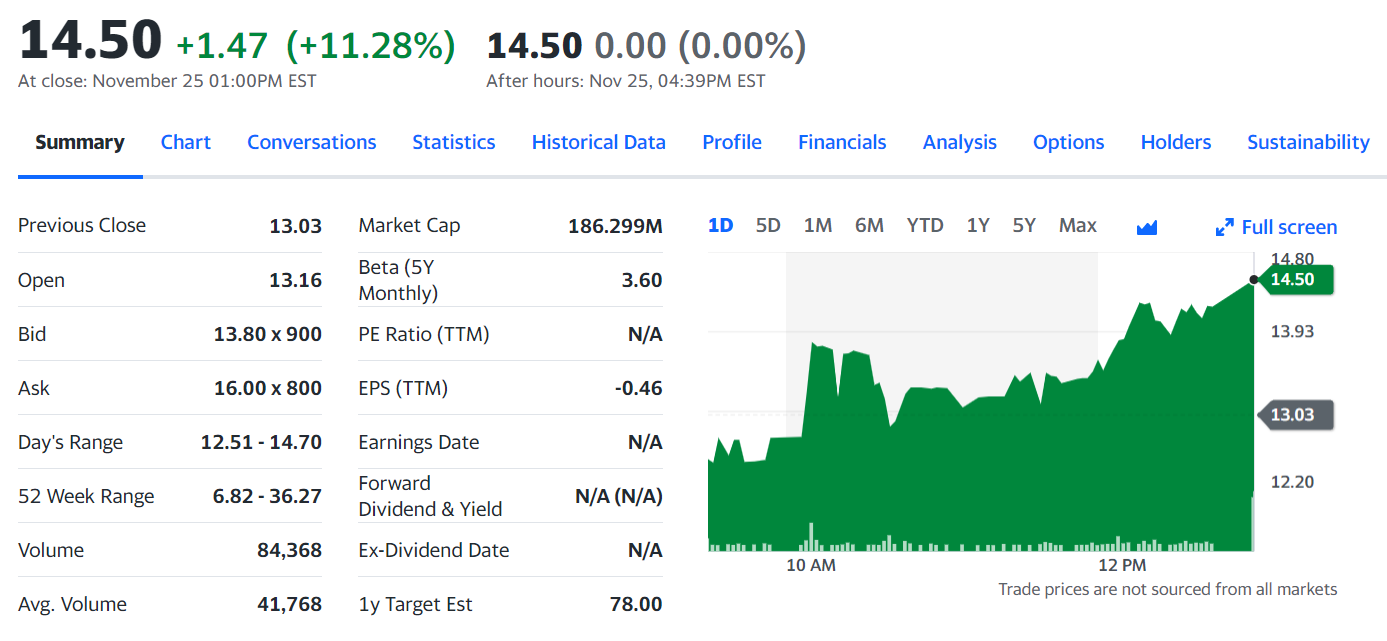The Short Squeeze On Sabby Has Begun - ALF, BCTX, GOED, GOVX
On June 15th we announced our four top microcap short squeeze picks to try to take down notorious small cap manipulator Sabby Management. They were Alfi, Inc. (ALF), BriaCell Therapeutics Corp. (BCTX) (BCT.V), 1847 Goedeker Inc. (GOED) and GeoVax Labs, Inc. (GOVX). Wallstreetbets censors DD on microcap stocks so we did our write up here instead. On June 16th we told you how buying the warrants were beneficial to creating a squeeze as funds use warrants in their inventory to facilitate shorting of the stock. Buying those warrants limits that ability. And on June 20th we told you to focus on ALF as we had good reason to believe that was the one on the brink of a squeeze. Please read those three write ups in detail if you want to understand the background of this movement. Otherwise just use the prediction on ALF as a sign that we might know what we are talking about.
That squeeze on ALF happened today:
ALF absolutely destroyed the short sellers today, with the stock price rising 109% to $16.29 and rising to over $17 after hours. The leveraging effect of the warrants we talked about was also demonstrated as ALFIW rose 252% to $11.80. The warrants tracked the stock less the $4.57 strike price nearly to a tee, though there were several times during the day when they traded below their intrinsic value. The end result being the picture above for the shorts and the chart below for the performance of these four stocks in the week since our first announcement.
There is little reprieve for short sellers as the major losses taken on ALF and GOED are barely noticeable on the mostly flat prices on BCTX and GOVX during that time. While GOED has "only" risen 31% since last week, keep in mind that its market cap is much bigger than the other three. The $98 million increase in market cap means that shorts lost as much on a dollar perspective as they did on ALF. That's what you need to pay attention to in this short squeeze movement. When Ortex announces short data on large cap stocks, they always announce the dollar value of those losses as opposed to percentages. The former paints a much clearer picture of the mounting losses.
Make sure to push forward while we have the momentum; next is BCTX
We are on the edge of pushing these funds to a major short covering across their entire portfolio. We have to push further by creating a squeeze in another stock ASAP. The next obvious choice is BCTX. Death is knocking on the hedge fund scammers' door. The only reason why BCTX went down this past week was the newly issued shares from warrant exercises being absorbed into the float. If you include this increase to shares outstanding, the market cap actually rose slightly. But now those warrants are out of existence and can no longer be used as insurance to short the stock.
People are smartly buying up the warrants. Despite the stock dropping 12% from $6.03 to $5.28 in the past week, the warrants have actually risen slightly from $1.63 to $1.70 during the same time frame. Buying these warrants out of the hedge funds' inventory will increase the likelihood of the squeeze.
Let's say a fund shorted 500,000 BCTX shares and owned 500,000 warrants. If the stock was to spike to $20 tomorrow at open, there is not too much issue with this for the fund. They just cover their short by exercising the warrants at $5.31 instead of having to worry about covering at $20. However, if people buy up the warrants now, the fund is enticed to reduce its risk exposure by covering their shorts rather than risk a massive blowout like what happened on ALF today.
Obvious question: Why would the funds want to sell the warrants if that's the tool they use as insurance to short the stock?
They wouldn't, not all of them necessarily. But if you read our previous pieces, they might not have a choice in a squeeze situation. Note that along with ALF and ALFIW, BCTXW also traded below its intrinsic value briefly last week, though not quite as extreme as ALF. What does this mean?
The BCTXW warrants have a strike price of $5.31. So in theory the warrants should never trade below $5.31 under the stock price or else there is arbitrage. For instance, if the stock goes to $10 and the warrants trade at $3, someone could buy the warrants at $3, sell or short sell the stock at $10, pay $5.31 to exercise the warrants and buy back their short of the stock at $10 for an effective price of $8.31, pocketing $1.69 per share in arbitrage. This is exactly what happened on June 2nd when the stock price hit $9 but the warrants traded well below intrinsic value. A week later the company announced that 2.4 million warrants were exercised, bringing in $13 million.
The funds don't WANT to sell their warrants, but they will in times of desperation to put a lid on the stock's price. Warrants were sold below their intrinsic value so that investors took advantage of the arbitrage, selling or short selling the shares to try to put selling pressure on the stock price. And on June 2nd it worked. However, now there are only about 3 million or so warrants left. If retail investors buy up shares and warrants, what happened on June 2nd to stop the stock's momentum might not work this time around. It could explode like ALF did.




So is Alf done or is going to the moon
ReplyDeleteprob done
ReplyDeleteTo the moon
ReplyDelete